





|
by Don Hollway _off_Korea_in_January_1952.jpg)
Douglas AD Skyraiders, McDonnell F2H Banshees, Grumman F9F Panthers and Vought F4U-5N Corsairs aboard USS Essex (CV-9) off Korea, January 1952 It was a new kind of war. In less than a decade America had sided with old enemies against former allies. It had retired its most famous general because he fought for total victory, and settled with bitter foes for nothing more than a stalemate. Worst of all, soldiers and sailors in Korea felt people back home knew little of their war, and could care less. That December of 1952 several US Navy squadron leaders convened in the stateroom of Task Force 77 commander, Rear Admiral John “Black Jack” Perry, aboard his flagship, the USS Essex (CV-9), to make sense of it for an American journalist. James A. Michener was on assignment for Reader’s Digest and the Saturday Evening Post, but secretly researching what would become his first great novel, and arguably the greatest film about the Korean War: The Bridges at Toko-Ri. Michener had been a Navy lieutenant commander during World War II, which led to his story collection, Tales of the South Pacific, subsequent Broadway musical South Pacific (both of which won Pulitzer Prizes) and the movie version (which won an Oscar). But 100 miles off the coast of Korea in the wintery Sea of Japan, he felt a long way from home. The United States had become the leader of the Free World. It had the Boeing B-52 Stratofortress, a nuclear submarine and the hydrogen bomb, but seemingly no longer any will to win. Michener wanted to know, “Have Americans lost their moral courage?” 
The “Bald Eagle of the Essex”: Commander Paul Gray of Hell’s Angels, Squadron VF-54. “After dinner, the Admiral asked each squadron commander to describe his experiences in flying over North Korea,” remembered Commander Paul Gray of Hell’s Angels, Squadron VF-54. “The main job was to interdict the flow of supplies coming south from Russia and China. The rules of engagement imposed by political forces in Washington would not allow us to bomb the bridges across the Yalu River where the supplies could easily have been stopped. We had to wait until they were dispersed and hidden in North Korea and then try to stop them.” Like his readers, Michener was enamored of the Navy’s flashy new jet fighters, the McDonnell F2H Banshee and Grumman F9F Panther. (His novel’s pilots would fly Banshees, and the film version’s Panthers.) But with no air-to-air refueling in those days, a Panther could only stay aloft for an hour and a half, and was so underpowered it could only pack four 250lb bombs. 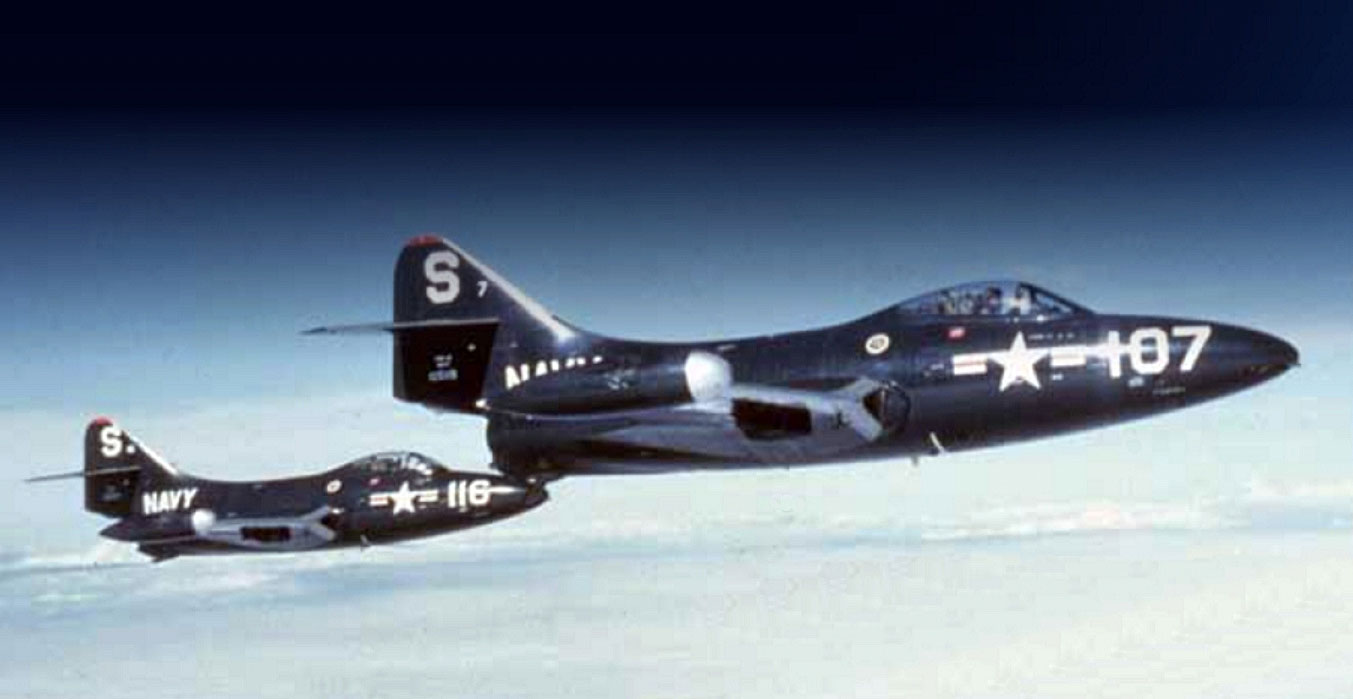
U.S. Navy Grumman F9F-2 Panther jets from Fighter Squadron VF-51, the Screaming Eagles, during a sortie over Korea, in 1951-52. VF-51 was assigned to Carrier Air Group 5 (CVG-5) aboard the aircraft carrier USS Essex (CV-9) for a deplyoment to Korea from 26 June 1951 to 25 March 1952. The pilot of the lead plane (“S-107”) IS Lt.JG George Russell. "S-116" is flown by Ens. Neil Armstrong, later the first man to set foot on the moon. The Hell’s Angels, on the other hand, had only recently traded their WWII-era Vought F4U Corsair for the Douglas AD-1 Skyraider—an old-school, prop-driven anachronism in a jet age. “[The Spad] could carry the same bomb load that a B-17 carried in WWII,” remembered Gray, “and after flying the 100 miles from the carrier, we could stay on station for 4 hours and strafe, drop napalm, fire rockets or drop bombs. The Skyraider was the right plane for this war.” “There was never any doubt that the big prop-driven AD Skyraiders were the Navy’s only aircraft able to destroy the bridges because they carried the big 2000-lb blockbuster bombs,” agreed Lt. Kenneth C. Kramer, an F9F pilot of Essex’s VF-51, the Screaming Eagles. “They came in so low before dropping their ordnance that they were sitting ducks because they were so close to those gun batteries.” 
This AD-2 Skyraider #122319 flew for VF-54, but was written off on Dec. 9, 1951, two months before the “Toko-Ri” missions.* Before and after views of an AD-4 Skyraider of VA-195 on a mission over Korea. Serial number appears to be #123937; if so, this aircraft was operating off USS Princeton (CV-37) when hit by AAA on Feb. 10, 1951. On landing it struck the barrier. Pilot Lt. Atlee F. Clapp survived, but the aircraft was written off.* (Both VA-195 on Princeton and VA-194 on Valley Forge used the B tail code.)* On the other hand, serial might be #123987, in which case aircraft went to the French Armee de l’Air and served over Algeria in 1961.* “VF-54 started with 24 pilots,” remembered Gray. “Seven were killed during the cruise….Due to the nature of the targets assigned, the attack squadrons seldom flew above 2000 or 3000 feet; and it was a rare flight when a plane did not come back without some damage from AA or ground fire.” Gray himself was shot down no less than five times, ditching in Wonsan Harbor so often that a squadron wag posted a sign in the wardroom: USE CAUTION WHEN DITCHING DAMAGED AIRPLANES IN WONSAN HARBOR. DON’T HIT COMMANDER GRAY. To his credit, Michener did not avoid the danger: “Media people sometimes see far more actual warfare than the average man in uniform, because in a sense they seek it out, or it seeks them out, and they cannot wait for mere chance to dictate what they will run into. They look for trouble.” A PR officer had warned Perry, “The adverse publicity would be damaging if Michener was lost on one of these raids.” The admiral declared, “He said he wanted to be one of us. If he’s game, I’m game.” 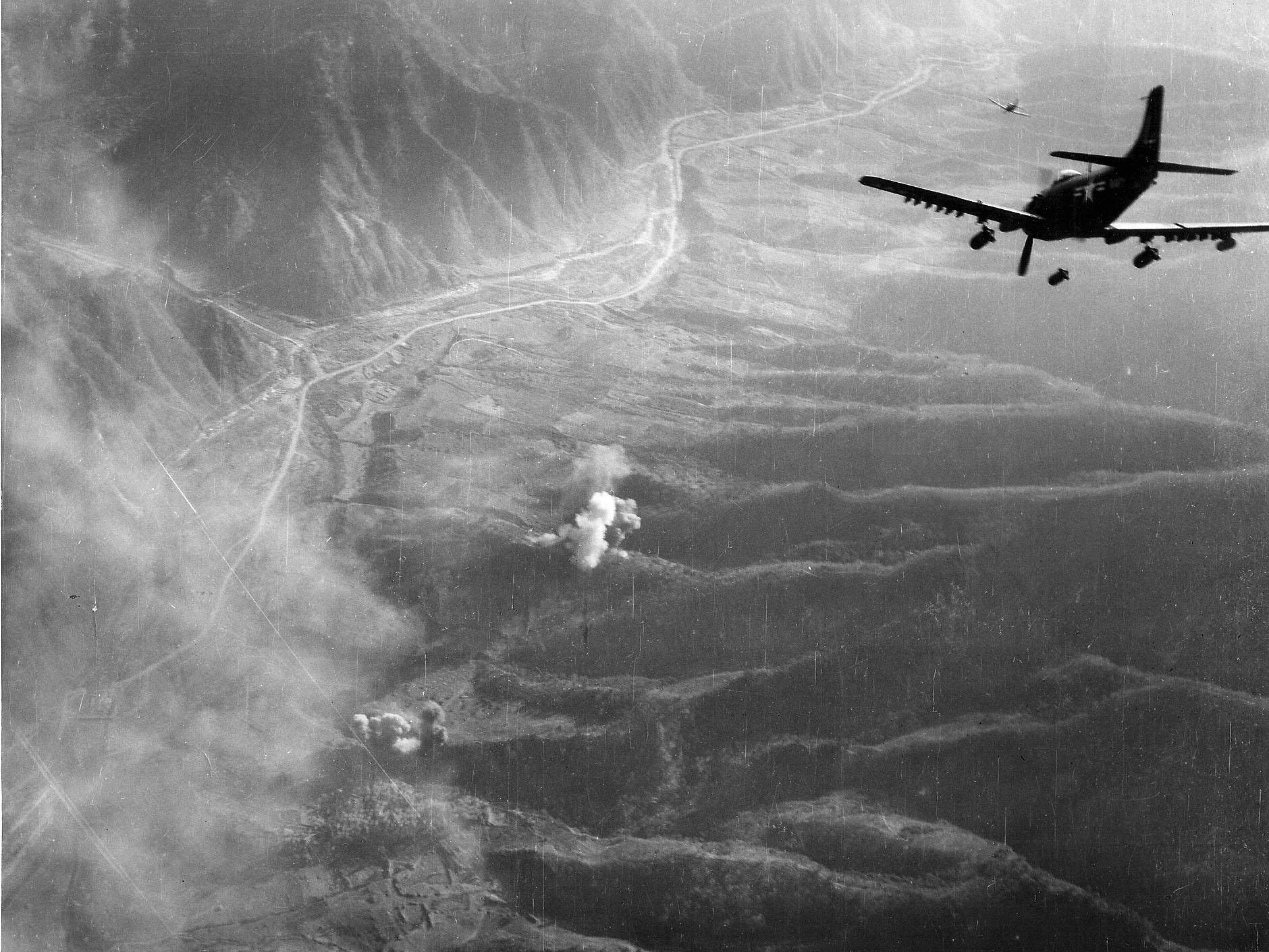
U.S. Navy Douglas AD Skyraider at the moment of bomb release over Korea. The Skyraiders appear to wear the tail code “L” of Carrier Air Group 7. CVG-7 made a single deployment to Korea from 20 May 1952 to 8 January 1953 aboard USS Bon Homme Richard (CV-31), with Attack Squadron 75, the Sunday Punchers, flying the AD-4. “I described how we had planned for the next day’s strike against some vital railway bridges,” remembered Gray, “…with extra care because the pre-strike pictures showed the bridges were surrounded by 56 anti-aircraft guns and we knew this strike was not going to be a walk in the park.” Gray led eight Skyraiders and four Corsairs against the bridges, at Majon-ri, just west of Wonsan. “The bridges supported railway tracks about three feet wide,” remembered Gray. “To achieve the needed accuracy, we would have to use glide bombing runs. A glide bombing run is longer and slower than a dive bombing run, and we would be sitting ducks for the AA batteries. We had to get the guns before we bombed the bridges.” For that the Navy Skyraiders packed 2000-pound bombs, each proximity-fuzed set to go off about 50 to 100 feet above the antiaircraft emplacement. “The shrapnel from those 2000 lb. bombs must have been deadly for the crews serving the guns and radars,” recalled Gray. “...From that moment on, it was just another day at the office. Only sporadic machine gun and small arms fire was encountered. We made repeated glide bombing runs and completely destroyed all the bridges. We even brought gun camera pictures back to prove the bridges were destroyed.” “The concept that made the first coordinated strike so successful was the use of jets—F9Fs and F2Hs—in conjunction with the Skyraiders and Corsairs,” recalled Kramer. “Up to that point this had never been done because the jets operated to a totally different schedule. We didn’t have air-to-air refuelling in those days so a Panther mission might last only 1.5 hours. On the other hand, the prop aircraft could remain in the air for at least four hours. Scheduling this type of coordinated attack required an enormous amount of detailed planning. All three squadrons had to arrive over the target at the same time.” 
Grumman F9F-2 Panther #127165, S/N 102, Squadron VF‑52, USS Valley Forge. “Once we got over the bridges the flak was extremely heavy—they were throwing everything they had up at us. Normally, we made only one bomb run as a result, and they were far more dangerous than at any other target. I believe there were about 20 bridge complexes in the general area we attacked. This group of rail bridges became known to the public as ‘Toko-ri’.” 
A U.S. Navy Douglas AD-2 Skyraider from attack squadron VA-702 Rustlers attacking a bridge in North Korea, in October 1951. VA-702 was assigned to Carrier Air Group 101 (CVG-101) aboard the aircraft carrier USS Boxer (CV-21) for a deployment to Korea from 2 March to 24 October 1951 “All of the pilots scheduled for the raid participated in the planning,” remembered Gray. “A close study of the aerial photos confirmed the 56 guns. Eleven radar sites controlled the guns. They were mainly 37mm with some five-inch heavies. All were positioned to concentrate on the path we would have to fly to hit the bridges ….The bridges supported railway tracks about three feet wide. To achieve the needed accuracy, we would have to use glide bombing runs. A glide bombing run is longer and slower than a dive bombing run, and we would be sitting ducks for the AA batteries. We had to get the guns before we bombed the bridges.” “To do this, we decided to take 12 planes; 8 Skyraiders and 4 Corsairs. Each plane would carry a 2,000 pound bomb with a proximity fuse set to detonate about 50 to 100 feet in the air. We hoped the shrapnel from these huge, ugly bombs going off in mid air would be devastating to the exposed gunners and radar operators. The flight plan was to fly in at 15,000 feet until over the target area and make a vertical dive bombing run dropping the proximity-fused bombs on the guns and radars.” Skyraider gun-camera film. (Silent) Enlarge “As we approached the target we started to pick up some flak, but it was high and behind us. At the initial point, we separated and rolled into the dive. Now the flak really became heavy. I rolled in first; and after I released my bomb, I pulled out south of the target area and waited for the rest to join up. One of the Corsairs reported that he had been hit on the way down and had to pull out before dropping his bomb. Three other planes suffered minor flak damage but nothing serious.” Making a solo follow-up pass, Gray drew fire from a surviving flak gun. “I got out of there in a hurry and called in the reserve Skyraider still circling at 15,000….His 2000 pound bomb exploded right over the target and suddenly things became very quiet. The shrapnel from those 2000 lbs. bombs must have been deadly for the crews serving the guns and radars.” With the flak suppressed, the bridge runs weren’t half as terrifying as Michener would paint them. “From that moment on, it was just another day at the office,” recalled Gray. “Only sporadic machine gun and small arms fire was encountered. We made repeated glide bombing runs and completely destroyed all the bridges. We even brought gun camera pictures back to prove the bridges were destroyed.” 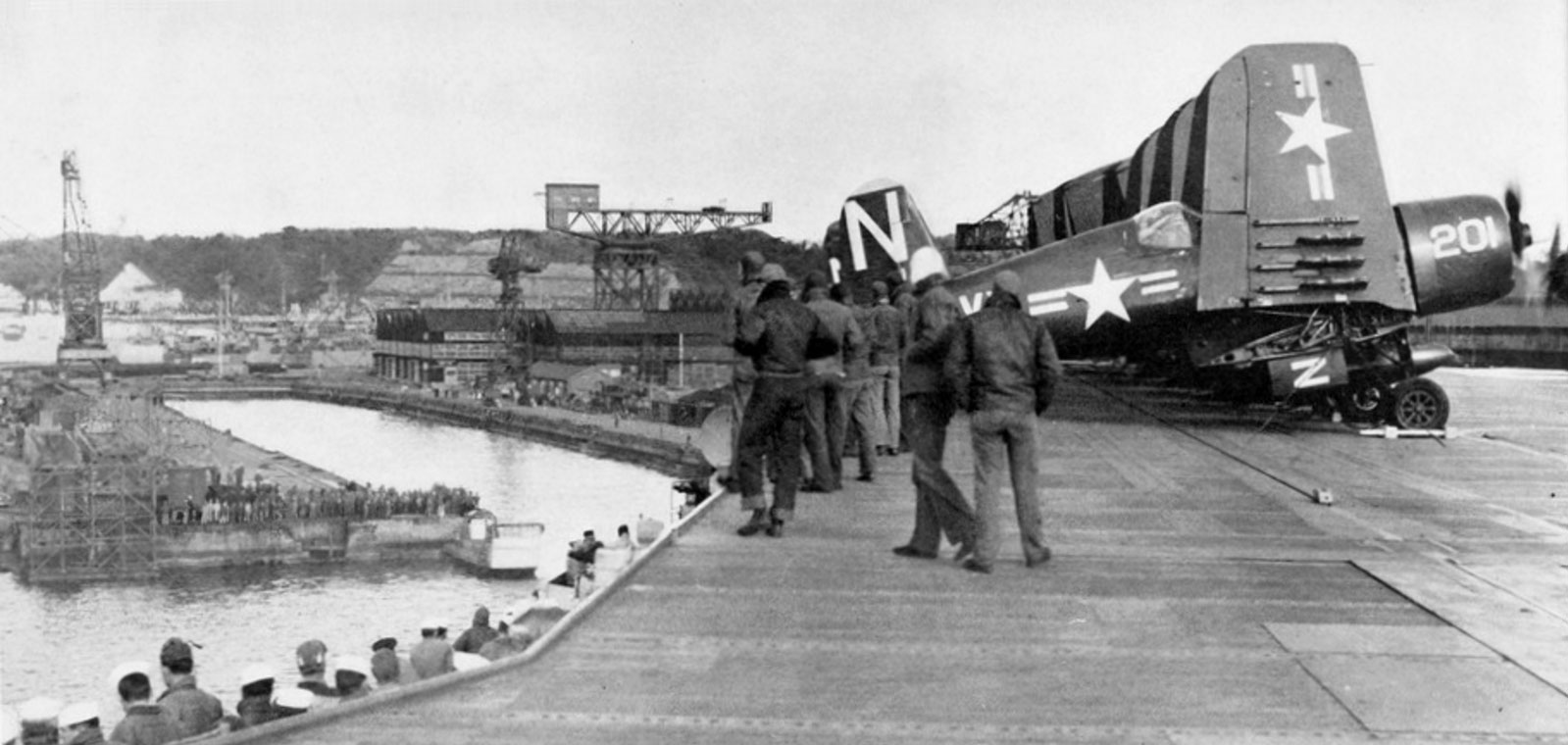
“Operation Pinwheel” 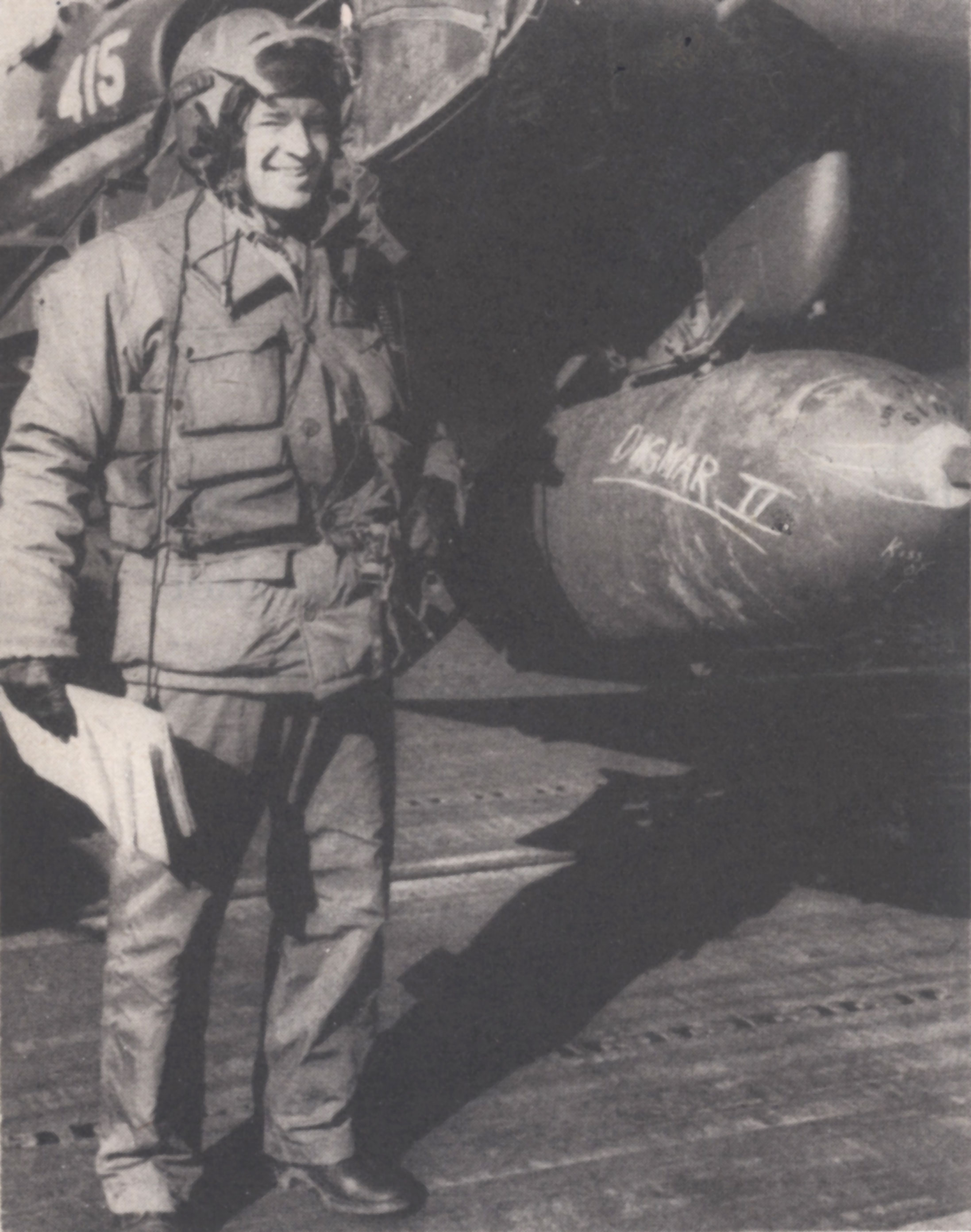
Cdr. Marshall Beebe, commander, Air Group 5. “Dagmar II” is a reference to the busty 1950s TV hostess. A non-combat incident at the end of the tour would also make an impression on Michener. “The operation was officially named OPERATION PINWHEEL. The pilots called it OPERATION PINHEAD,” remembered Gray of the Essex’s arrival at Yokosuka, Japan. “….The Corsairs and Skyraiders were to be tied down on the port side of the flight deck; and upon signal from the bridge, all engines were to be turned up to full power to assist the tugs in pulling the ship along side the dock.” To avoid burning up their engines, though, the pilots agreed among themselves to run them at no more than half power. Commander Marshall Beebe, the ship’s Commander Air Group (CAG), bore the wrath of Captain Austin W. Wheelock (henceforth to be remembered as “Wheelchock”), and put all the prop pilots “in hack”—confined to the ship, no R&R. But when Perry found out about it, Beebe got it from him, too. Gray recalled, “He was obviously in far worse condition than when the ship’s CO got through with him….His only words were, ‘The hack is lifted. All of you are free to go ashore. There will not be any note of this in your fitness reports. Now get out of here and leave me alone.’” (Beebe’s consolation prize was to have Michener’s novel dedicated to him, and to serve as technical advisor on the film.) 


USS Valley Forge (CV-45) 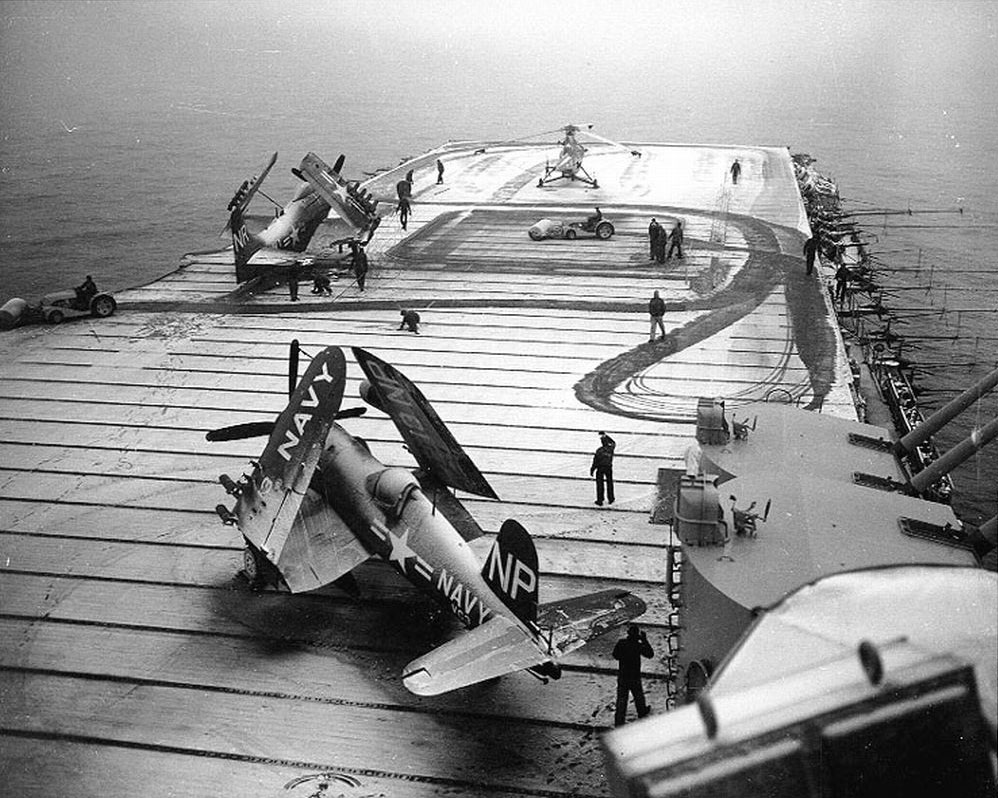
A long way from the South Pacific: _Duane_Thorin.jpg)
Chief Petty Officer (Aviation Pilot) Duane Thorin's characteristic green baseball cap inspired Michener's top-hatted “Mike Forney,” (Mickey Rooney), though Thorin was neither a drinker nor a brawler. US Navy photo, courtesy Christina Thorin More When Admiral Perry transferred his flag to the attack carrier USS Valley Forge (CVA-45), Michener went along. The “Happy Valley” was then on its record fourth tour of Korea, and earning a darker nickname: “Death Valley.” Since early December her air group had lost eight aviators, starting with 25-year-old Harry Ettinger of VC-35, the “Night Hecklers.” On his first mission, Ettinger’s AD-4NL Skyraider took a hit. Ettinger and his crew of two bailed out west of Wonsan. Almost two months later, the morning of Feb. 8th, the pilots of the Valley Forge learned that Ettinger was not dead, but had been rescued from captivity by sympathic North Koreans and a team of partisan guerillas operating behind enemy lines. They were making for the coast and needed a helicopter pickup. 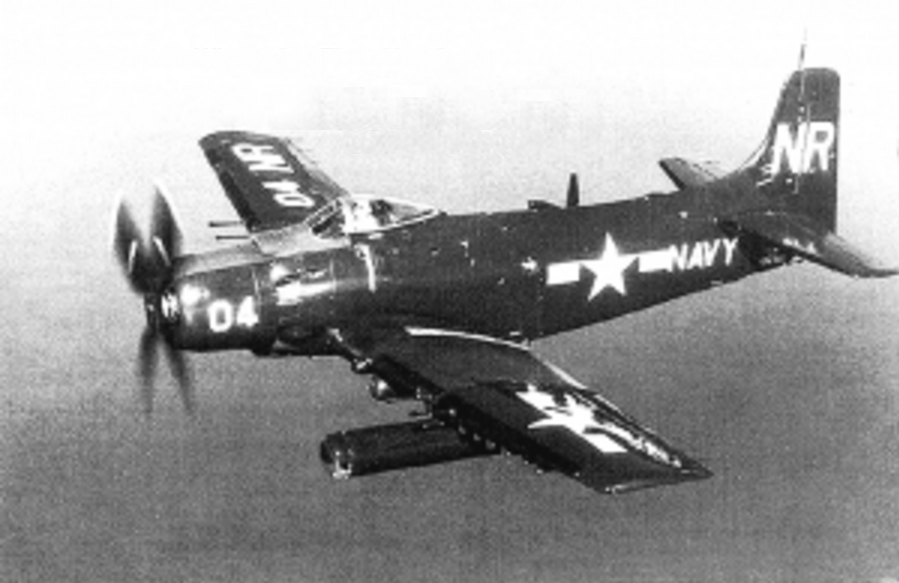
LTjg Harry Ettinger in his AD-4NL Skyraider. The AD-4NL was specialized for night interdiction, with a crew of two besides the pilot, inside the spacious fuselage. The rescue fell to Chief Petty Officer (Aviation Pilot) Duane Thorin on the cruiser Rochester. One of the Navy’s first chopper jocks, Thorin had made over 130 pickups from hostile territory with his little Sikorsky HO3S-1. He was skeptical of this mission, particularly when an Army Intel operative insisted not only on coming along, but also loading down his “Horse” with medicines and a radio for the partisans. “Weight is very critical in this machine; especially in this kind of operation,” Thorin warned. “…We could carry very little, no more than 150 pounds including his transceiver. And it was stressed that it must all be out of the helicopter before we brought the man [Ettinger] aboard.” 
Sikorsky HO3S-1 #124340, Squadron HU-1, USS Rochester. 
A USMC Corsair is gets a final check before launching from the USS Sicily (CVE-118) on a strike against enemy forces in Korea.The photo was dated Nov. 1950 but may well have been taken a month or so earlier. At 6:00 AM Friday the 8th, three Corsairs and three Skyraiders took off from the Valley Forge as ResCAP: rescue combat air patrol. The frozen hillside pickup site appeared clear of enemy troops, but its terraced, stair-stepped rice paddies were too narrow for Thorin’s Sikorsky to set down. He planned to hover while the supplies were offloaded and the passenger put aboard, but when the Horse came down the “stretcher-bound” Ettinger darted out from cover. Thorin shouted at the Army agent: “Dump that stuff out! Right now!” Too late. Ettinger hurled himself aboard. Under all three men plus the extra gear, the chopper grounded, one wheel off the terrace. It tipped, rolled, and struck its rotor blades on the frozen ground. 
WWII Hellcat and Corsair pilot Lt. Cdr. Robert “Iron Pants” Schreiber led VF-194, the Main Battery, over Korea. _Dick_Kaufman_VF-194.jpg)
Lt(jg) Dick Kaufman flew Schreiber’s wing on the “Toko-ri” mission.
Shown here on USS Boxer, 4 November 1953 Out at sea Valley Forge prepared to launch the morning’s scheduled mission. At Samdong-ni, near the villages of Poko-ri and Toko-san (names Michener would later combine for his fictional Toko-ri), three bridges crossed the bottom of a deep, winding river valley. Recon photos had revealed the heights were studded with Russian-made 37mm radar-controlled quad cannons. Panthers would speed ahead to take out the guns, and two Corsairs would try to keep any stray Korean heads down, but the bridges were up to the Skyraiders. Lt. Cdr. Robert “Iron Pants” Schreiber of VF-194 would lead the strike. “We had no illusions as to what we were in for,” remembered Schreiber’s wingman, Lt. (j.g.) Richard Kaufman. Lieutenant Bob Komoroff, who had been best man at Kaufman's wedding, would lead the second section, with Ensign Marv Broomhead as last man through. “I was very uncomfortable,” recalled Kaufman, “knowing that the rescue helicopter from the Rochester was not available.”
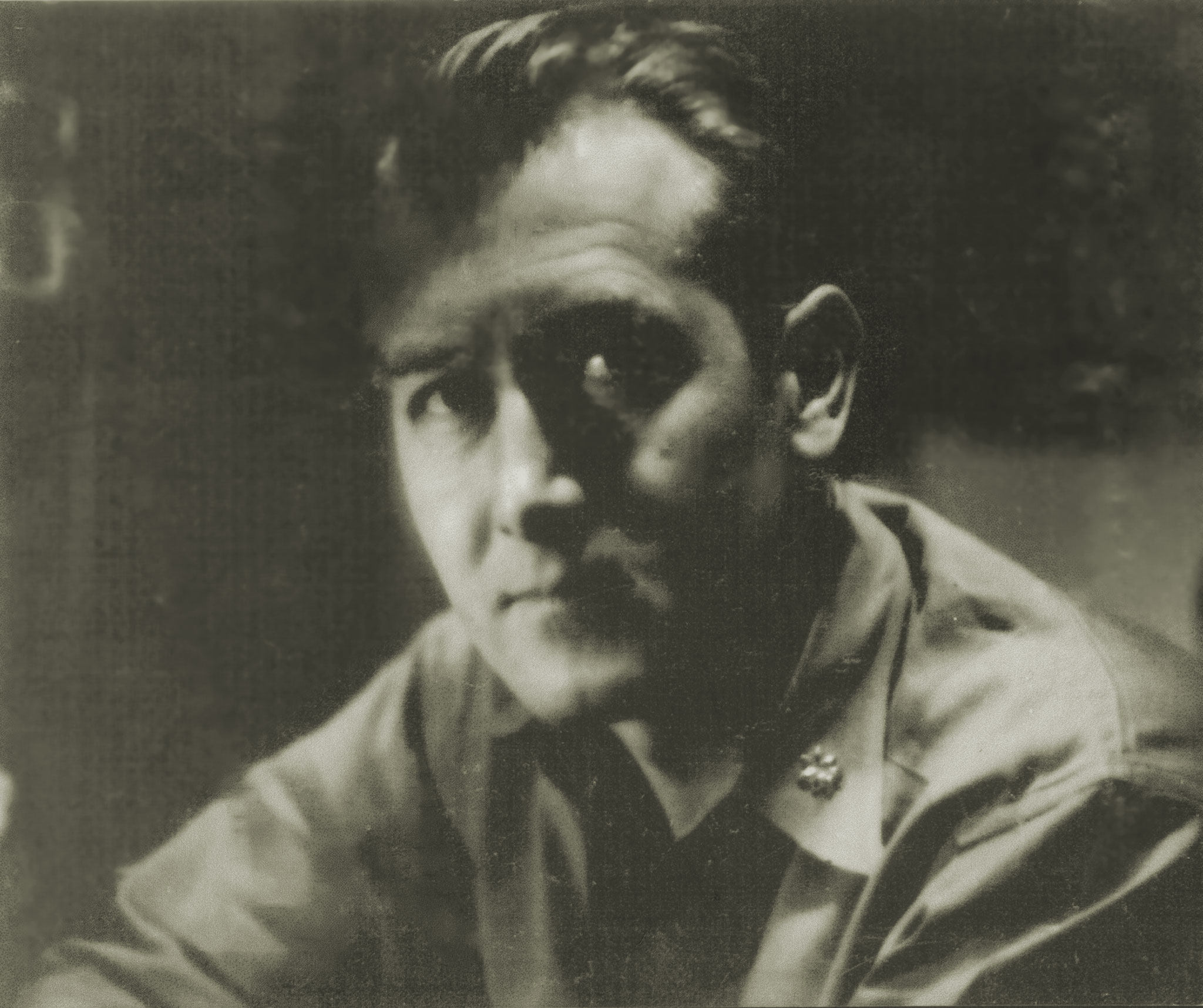
Though he took no part in the Feb. 8th missions, VF-194 executive officer LCDR Donald “Pappy” Brubaker so inspired Michener that he named his main character “Harry Brubaker.” A Denver reservist called to war, Brubaker won the Distinguished Flying Cross in April 1952 for making two bomb runs against North Korean bridges despite being hit in the head by anti-aircraft fire.* Shown here in Dec. 1951. Photo courtesy Richard Kaufman. “We spread out in a loose tailgate racetrack pattern 12,000 feet above the bridges,” Kaufman recalled, “so as to attack out of the sun. We were to drop the three centerline and inboard 1,000-pound bombs on the first run, saving the 250-pounders carried on the wings if necessary.” Seeing little evidence of flak suppression, they guessed their jet escort had hurried on to the Thorin crash. “The Panthers put the gun crews on alert,” Kaufman realized, “so when we arrived a half hour later, they were waiting for us.” As Schreiber’s dark blue AD rolled into its bomb run, Kaufman saw the snowy white valley erupt: “All hell broke loose. In my 30 missions over North Korea thus far, it was the heaviest flak I had ever seen.” And it was his turn to head into it. 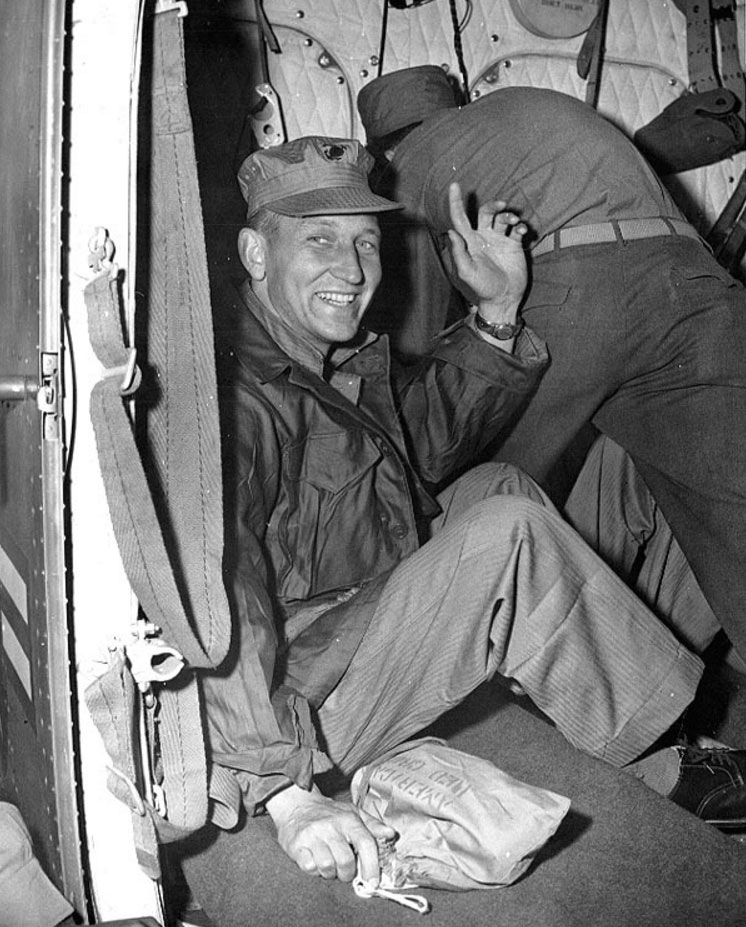
At Samdong-ni Ensign Marvin S. Broomhead was on just his third flight since returning from an emergency visit home, where his wife had been paralyzed in a car accident. “When bomb switches are armed, the pickle on the stick becomes the release mechanism. We were to drop three 1000lb bombs on the first run, saving the eight 250 pounders carried on the wings. For the dive, I set the Manifold pressure at 15" (idle), prop pitch at full RPM, dive brakes open, and peeled off from 12 thousand feet. As I descended into the valley, I was hanging by my shoulder straps in a 60 degree dive, focusing on the target, and finger on the pickle of the stick. I could see Schreiber pulling out ahead of me and folding his dive brakes. At three thousand feet I pickled my bombs, folded my dive brakes all in one motion and pushed the throttle to a full 56” of mercury. From that point on I was concentrating on the 4 g pullout on g-meter at 360 knots, and climbing for altitude. I really didn't have time to concern myself with the flak tracers and bursts that were occurring all around me." 
Douglas AD-3 Skyraider #122842, S/N 401, Squadron VF‑194. USS Valley Forge.Flown by Ens. Marvin Broomhead when he was hit over Samdong-ni and crashed several miles to the east. Feb. 8, 1952.* 
Vought F4U-5N Corsair, #124495, S/N 2, VC-3 Detachment. USS Valley Forge, February 1952. Lt. Ray Edinger, executive officer of VF-653, brings his stricken Corsair aboard the Valley Forge, February 8, 1952. Note, on impact, hung HVAR rocket flying off port wing. (Silent) Courtesy Richard Kaufman from his DVD, A Carrier Pilot in the “Forgotten War.” 1 hour, with narration & music. Lt. Ray Edinger’s Corsair took ground fire over the Thorin crash and began leaking hydraulic fluid. It meant putting down on Valley Forge, with no flaps, no locked-down landing gear, maybe not so much as a tail hook, not to mention the hung rocket still on his wing. But having made it out over the water—and against the advice of the carrier crew, who all but ordered him to ditch or divert to K-18—Edinger was determined to come aboard, no matter what. “They wouldn't let me land until…they put the [crash barrier] fences up and were going to put a line of donkeys [tow vehicles] there.” His first approach—no flaps, straight in—was too fast, and Edinger got a wave-off. He wound the F4U back around the circuit and hung it in the air at near-stall speed, hose-nose so high he had to slide open the canopy and stick his head out to see the LSO give him the cutthroat signal to chop throttle. 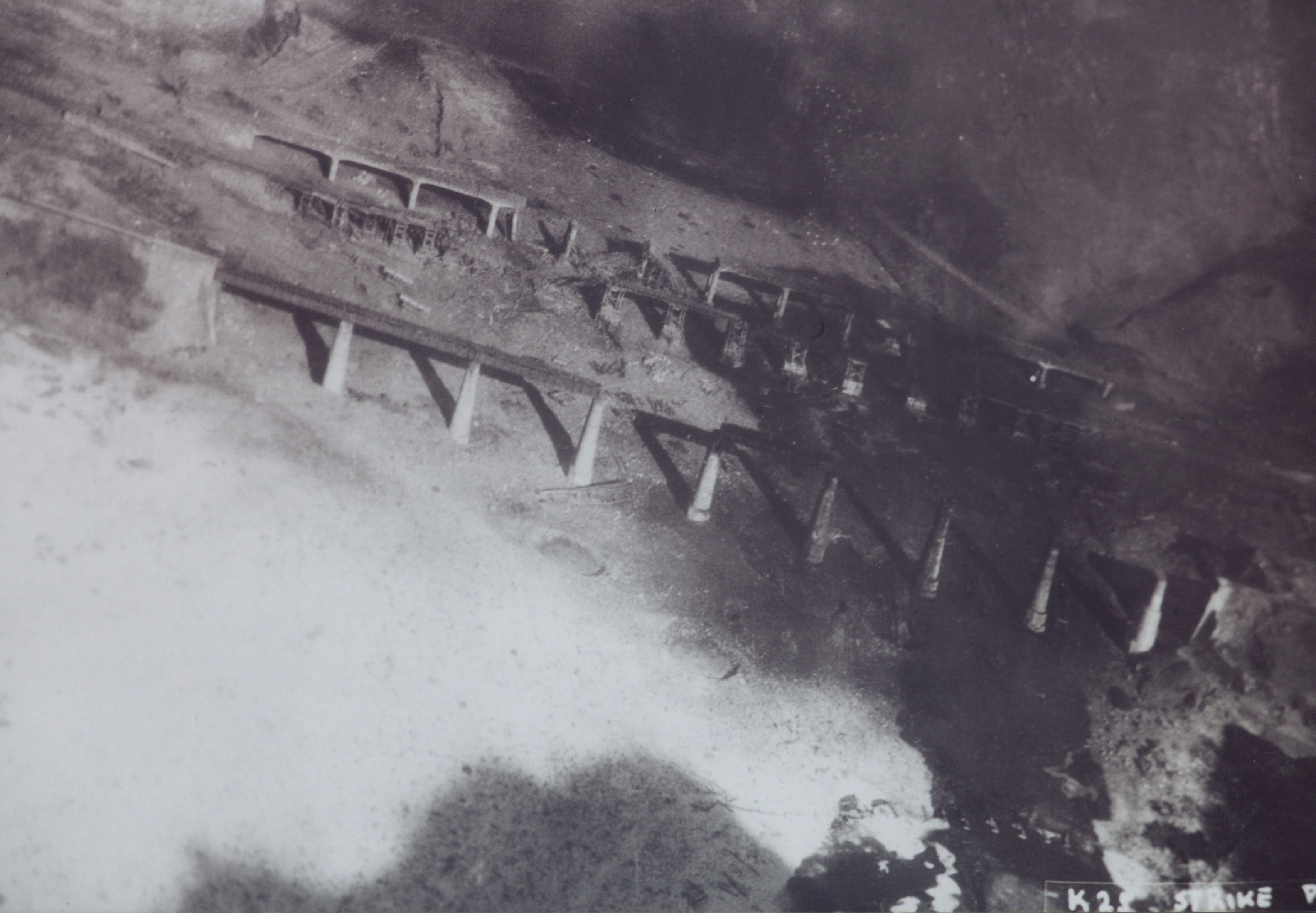
The actual “Bridges at Toko-Ri” (actually Samdong-ni) after the Skyraider strike of Feb. 8, 1952

Life Magazine July 6, 1952 “I cherish those experiences as among the most exciting I've ever had,” Michener would recall. “When the time came to write the novel…I strove to capture each violent action and its significance.” He would become famous for massive historical epics. His story of Korea, published in its entirety in one issue of Life magazine, was one of his shortest, though Michener always called it his “best single piece of writing.” For most Americans, The Bridges at Toko-Ri remains their only experience of the “Forgotten War.” 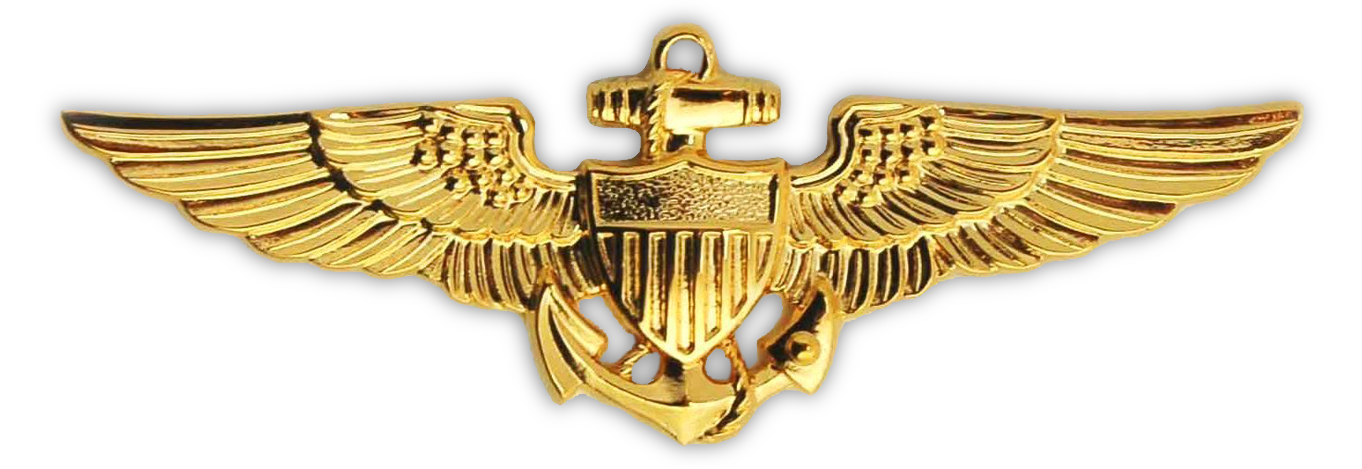
About the authorAuthor/illustrator/historian Don Hollway has been published in Aviation History, Excellence, History Magazine, Military Heritage, Military History, Civil War Quarterly, Muzzleloader, Porsche Panorama, Renaissance Magazine, Scientific American, Vietnam, Wild West, and World War II magazines. His work is also available in paperback, hardcover and across the internet, a number of which rank extremely high in global search rankings. More from Don HollwayComment Form is loading comments...
|
